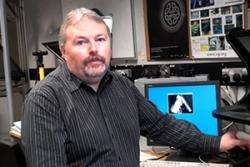Creating a 'computer-simulated' virtual patient to train clinicians

In the future, should you need complicated surgery, the surgeon will be able to prepare and even practice for the procedure on a virtual simulation of your own body or body part that needs attention.
The technology is currently in development to create complete whole body 'simulations' to train surgeons and other medical professional how to undertake various medical procedures, using 'virtual' dummies that appear to be there, and even 'feel' as though they're there, by use of 3D computer graphics haptic or 'force feedback' devices.
Leading the field in Wales in developing this technology is Bangor University's Professor Nigel John, an expert in visualisation technology at the School of Computer Science. Prof John leads the Advanced Medical Image Analysis and Visualisation Unit within the School and also the Research Institute of Visual Computing (RIVIC), in partnership with the NHS in Wales and Aberystwyth, Cardiff and Swansea Universities. One of the main focuses of Prof John's team at Bangor is adapting visual computing and virtual reality to provide cost-effective learning for a range of medical procedures.
Prof John has recently returned from a Winston Churchill Memorial Trust Travelling Fellowship to Australia and Singapore (www.wcmt.org.uk/). The visit enabled Professor John to establish opportunities for international collaboration on projects that can contribute to the creation of a Virtual Interactive Patient (VIP) - a patient specific computerised database containing the required image data, physiology, and pathology models that can be interacted with in real time using natural senses and skills. The objective is for the VIP to become both an accepted tool in the medical education curriculum; and an aid to the medical practitioner carrying out the daily tasks of their profession. Prof John established strong links with the Australian eHealth Research Centre in Brisbane, and the Nanyang Technological University in Singapore.
Prof John said: "We are now planning to work together on projects for training endoscopy procedures, and for image driven haptics – devices which allow force and tactile feedback to be added to interaction with medical images."
While computer-based simulation technology can provide a safe environment for training medical procedures, there are many issues to overcome, from technology limitations, human factors, and validation.
Professor Nigel John's team at Bangor University have already developed simulations for particular medical procedures used by interventional radiologists for inserting catheters into arteries - and a feedback system for inserting a needle into a kidney or liver - where the trainee holding the 'needle' feels resistance as the needle is pushed through 'virtual flesh' that can be seen on the screen. If the needle accidentally hits a rib then the force resistance is increased to stop the needle as it cannot penetrate bone.
They also recently launched a tablet computer app that can be used by trainee brain surgeons to practice a procedure to drain excess fluid causing pressure inside the brain, a procedure commonly performed in neurosurgery departments.
Llyr ap Cenydd, from the Advanced Medical Imaging and Visualization Unit, developed the 'VCath' app, designed to take a neurosurgical trainee through the steps of positioning and inserting a catheter into the brain of a virtual 3D patient. He worked in collaboration with Mr Nick Phillips, Consultant Neurosurgeon at Leeds General Infirmary, and Prof William Gray, Professor of Functional Neurosurgery, Institute of Psychological Medicine and Clinical Neurosciences, Cardiff University.
Professor John commented: "Training using this and other cost effective simulators will help to provide medical trainees with the necessary skills for safe and effective completion of various procedures. They provide a platform for repeat practice and have the potential to improve patient outcomes, safety and experience. At Bangor University we are at the forefront of many of these developments and will shortly be starting work on a new project funded by the European Union to provide a training tool for anesthetists."
Commenting on the VCath app, Nick Phillips, Consultant Neurosurgeon and Clinical Director at Department of Neurosurgery, Leeds General Infirmary said:
"Neurosurgery is a high risk speciality and providing safe training opportunities for surgeons is always a challenge. This training tool allows the trainee to acquire most of the skills needed for this procedure in an environment that is safe and risk free. It promotes discussion with trainers and is excellent at embedding the required skills"
Prof William Gray, Professor of Functional Neurosurgery, Institute of Psychological Medicine and Clinical Neurosciences, Cardiff University said:
"VCath is an exciting new iPad application which allows trainees to learn the basic theoretical and practical skills of ventricular catheterisation in a realistic simulated environment. It is a valuable tool for enhancing the learning of a core skill set and is a significant advance for applying simulation to neurosurgical training"
















